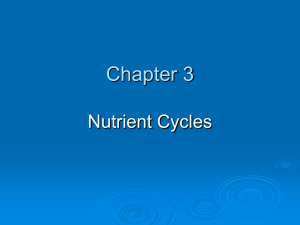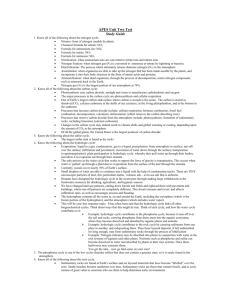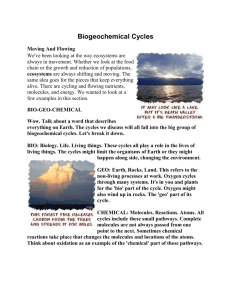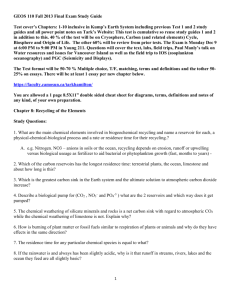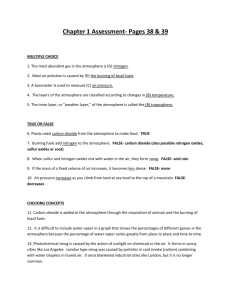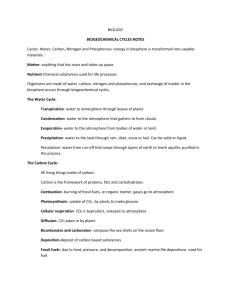Practice Quiz with answers - Liberty Union High School District
advertisement
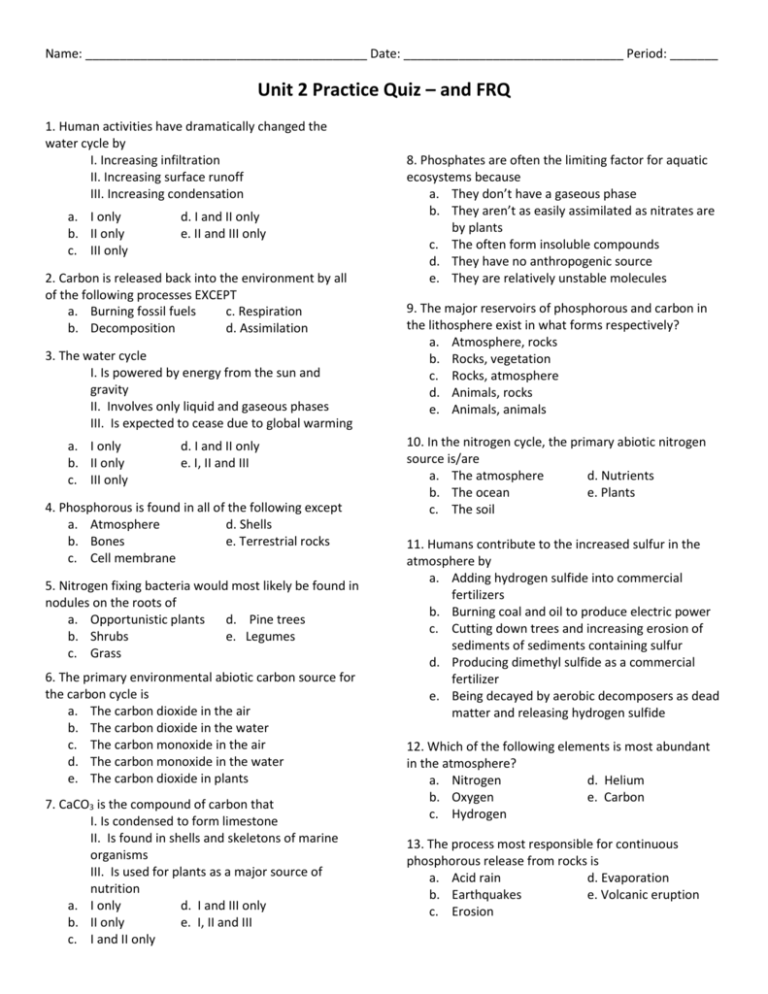
Name: _________________________________________ Date: ________________________________ Period: _______ Unit 2 Practice Quiz – and FRQ 1. Human activities have dramatically changed the water cycle by I. Increasing infiltration II. Increasing surface runoff III. Increasing condensation a. I only b. II only c. III only d. I and II only e. II and III only 2. Carbon is released back into the environment by all of the following processes EXCEPT a. Burning fossil fuels c. Respiration b. Decomposition d. Assimilation 3. The water cycle I. Is powered by energy from the sun and gravity II. Involves only liquid and gaseous phases III. Is expected to cease due to global warming a. I only b. II only c. III only d. I and II only e. I, II and III 4. Phosphorous is found in all of the following except a. Atmosphere d. Shells b. Bones e. Terrestrial rocks c. Cell membrane 5. Nitrogen fixing bacteria would most likely be found in nodules on the roots of a. Opportunistic plants d. Pine trees b. Shrubs e. Legumes c. Grass 6. The primary environmental abiotic carbon source for the carbon cycle is a. The carbon dioxide in the air b. The carbon dioxide in the water c. The carbon monoxide in the air d. The carbon monoxide in the water e. The carbon dioxide in plants 7. CaCO3 is the compound of carbon that I. Is condensed to form limestone II. Is found in shells and skeletons of marine organisms III. Is used for plants as a major source of nutrition a. I only d. I and III only b. II only e. I, II and III c. I and II only 8. Phosphates are often the limiting factor for aquatic ecosystems because a. They don’t have a gaseous phase b. They aren’t as easily assimilated as nitrates are by plants c. The often form insoluble compounds d. They have no anthropogenic source e. They are relatively unstable molecules 9. The major reservoirs of phosphorous and carbon in the lithosphere exist in what forms respectively? a. Atmosphere, rocks b. Rocks, vegetation c. Rocks, atmosphere d. Animals, rocks e. Animals, animals 10. In the nitrogen cycle, the primary abiotic nitrogen source is/are a. The atmosphere d. Nutrients b. The ocean e. Plants c. The soil 11. Humans contribute to the increased sulfur in the atmosphere by a. Adding hydrogen sulfide into commercial fertilizers b. Burning coal and oil to produce electric power c. Cutting down trees and increasing erosion of sediments of sediments containing sulfur d. Producing dimethyl sulfide as a commercial fertilizer e. Being decayed by aerobic decomposers as dead matter and releasing hydrogen sulfide 12. Which of the following elements is most abundant in the atmosphere? a. Nitrogen d. Helium b. Oxygen e. Carbon c. Hydrogen 13. The process most responsible for continuous phosphorous release from rocks is a. Acid rain d. Evaporation b. Earthquakes e. Volcanic eruption c. Erosion 14. Carbon is restored to the environment by all of the following EXCEPT a. Cellular respiration b. Earthquakes c. Forest fires d. Precipitation e. Volcanic eruption Base your answers to question 15 (to the right) on the diagram below. 15. The region labeled A refers to a. The action of denitrifying bacteria b. The action of nitrogen-fixing bacteria c. The process of ammonification d. Photosynthesis e. Transpiration 16. Which cycle does the most in shaping the earth’s landscape? a. Nitrogen cycle d. Hydrological cycle b. Sulfur cycle e. Carbon cycle c. Phosphorous cycle 17. A sample of radioactive waste has a half-life of 10 years and an activity level of 2 curies. After how many years will the activity level of this sample be 0.25 curie? a. 10 years d. 40 years b. 20 years e. 80 years c. 30 years 18. Which of the following is an inorganic compound? a. Ethanol (CH3COOH) b. Benzene (C6H6) c. Table salt (NaCl) d. Sucrose (C12H22O11) e. Propane (C3H8) Additional textbook questions to practice: page 49, questions #2-4 Answer Key: 1-D, 2-D, 3-A, 4-A, 5-E, 6-A, 7-C, 8-C, 9-C, 10-A, 11-B, 12-A, 13-C, 14-D, 15-A, 16-D, 17-C, 18-C Textbook answers: 2-D, 3-E, 4-C Practice FRQ – From 2009, Question 1 (d) Earth’s natural nitrogen cycle occurs in several steps. Describe one chemical transformation that occurs in the natural nitrogen cycle and discuss the importance of that transformation to an ecosystem.





